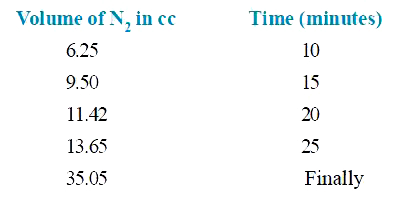The decomposition of ammonium nitrate in aqueous solution was studied by placing the apparatus in a thermostate maintained at a particular temperature. The volume of nitrogen gas collected at different intervals of time was as follows:

From the above data prove that the reaction is of the first order.
For a first order reaction,
k=2.303tlog.aa−x
From the equation , V∞∝a
V∞−Vt∝a−x
Hence k=2.303tlog.V∞V∞−Vt
In the present case V∞=35.05cm3. The value of R at each instant of time can be calculated as follows:

Values of .k. come nearly constant and hence the reaction is first order.
Topper's Solved these Questions
- BOOK - PREMIERS PUBLISHERSCHAPTER - CHEMICAL KINETICS EXERCISE - OTHER IMPORTANT QUESTIONS & ANSWERS (I. Choose the correct answer.)28videos
CHEMICAL KINETICS
- BOOK - PREMIERS PUBLISHERSCHAPTER - CARBONYL COMPOUNDS AND CARBOXYLIC ACIDSEXERCISE - OTHER IMORTENT QUESTIONS & ANSWERS (ANSWER THE FOLLOWING QUESTIONS)88videos
CARBONYL COMPOUNDS AND CARBOXYLIC ACIDS
- BOOK - PREMIERS PUBLISHERSCHAPTER - CHEMISTRY IN EVERYDAY LIFEEXERCISE - OTHER IMPORTANT QUESTIONS& ANSWERS (ANSWER THE FOLLOWING QUESTIONS)63videos
CHEMISTRY IN EVERYDAY LIFE
Similar Questions
The following data are for the decomposition of ammonium nitrate in aqueous solution :

The order of the reaction is:View SolutionIn an experiment on the decomposition of an aqueous NH4NO2 at a certain temperature, the volume of nitrogen gas collected at different intervals of time was as follows:
∣∣∣Time (s)11902300∞Vol ofN2(mL)5.007.309.50∣∣∣
Show how the above data illustrate that the reaction is of first order.
Note: This is an example of direct-estimation of Product, i.e., N2.View Solution
Knowledge Check
- Question 1 - Select One
The following data are for the decomposition of ammonium nitrate in aqueous solution :

The order of the reaction is:AZeroBOneCTwoDThree
In an experiment on the decompoistion of an aqueous NH4NO2 at a certain temperature, the volume of nitrogen gas collected at different intervals of time was as follows:
∣∣∣Time (s)11902300∞Vol ofN2(mL)5.007.309.50∣∣∣
Show how the above data illustrate that the reaction is of first order.
Note: This is an example of direct-estimation of Product, i.e., N2.View SolutionThe decomposition of an aqeous solution of ammonium nitrite was studied. The volume of nitrogen gas collected at
Time (minutes)101520∞Vol.of N2(mL)6.259.0011.4035.05
From the above data prove that the reaction is of the first order.View SolutionHydrolysis of methyl acetate in aqueous solution has been studied by titrating the liberated acetic acid against sodium hydroxide. The concentration of the ester at different times is given below:

Show that it follows a pseudo first order reaction, as the concentration of water remains nearly constant (55 mol L−1) during the course of the reaction. What is the value of k'in this equation? Rate =k'[CH3COOCH3][H2O]View SolutionHydrolysis of methyl acetate in aqueous solution has been studied by titrating the liberated acetic acid against sodium hydroxide. The concentration of the ester at different times is given below:

Show that it follows a pseudo first order reaction, as the concentration of water remains nearly constant (55 mol L−1) during the course of the reaction. What is the value of k'in this equation? Rate =k'[CH3COOCH3][H2O]View SolutionHydrolysis of methyl acetate in aqueous solution has been studied by titrating the liberated acetic acid against sodium hydroxide. The concentration of the ester at different times is given below:

Show that it follows a pseudo first order reaction, as the concentration of water remains nearly constant (55 mol L−1) during the course of the reaction. What is the value of k'in this equation? Rate =k'[CH3COOCH3][H2O]View SolutionThe decomposition of H2O2 in aqueous solution is a reaction of first order . How can it be justified from the following data :
where x is the volume (mL) of KMnO4 require to titrate a definite colume of H2O2 ?View SolutionThe decomposition of arsine (AsH3) into arsenic and hudrogen is a first order reaction . The decomposition was studied at constant volume and at constant temperature. The pressures at different times are as follows :
t(h)05.56.58p(atm):0.96541.061.0761.1
Calculate the velocity constant .View Solution

